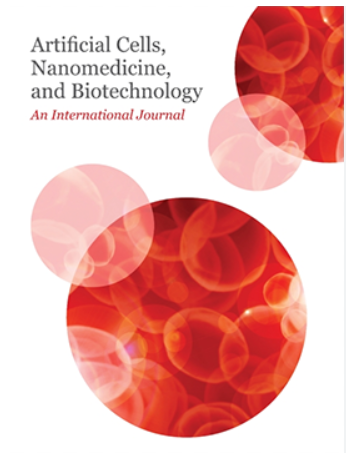Antibacterial activity of nano zinc oxide green-synthesised from Gardenia thailandica triveng. Leaves against Pseudomonas aeruginosa clinical isolates: in vitro and in vivo study
IF 4.5
3区 生物学
Q1 BIOTECHNOLOGY & APPLIED MICROBIOLOGY
Artificial Cells, Nanomedicine, and Biotechnology
Pub Date : 2022-04-01
DOI:10.1080/21691401.2022.2056191
引用次数: 28
Abstract
Abstract The increasing emergence of bacterial resistance is a challenge for the research community, thus novel antibacterial agents should be developed. Metal nanoparticles are promising antibacterial agents and could solve the problem of antibiotic resistance. Herein, we used Gardenia thailandica methanol extract (GTME) to biogenically synthesise zinc oxide nanoparticles (ZnO-NPs). The characterisation of ZnO-NPs was performed by UV spectroscopy, FTIR, scanning and transmission electron microscopes, dynamic light scattering, and X-ray diffraction. The antibacterial activity of ZnO-NPs was studied both in vitro and in vivo against Pseudomonas aeruginosa clinical isolates. Its minimum inhibitory concentration values ranged from 2 to 64 µg/mL, and it significantly decreased the membrane integrity and resulted in a significant increase in the inner and outer membrane permeability. Also, the ZnO-NPs treated cells possessed a distorted and deformed shape when examined by scanning electron microscope. The in vivo study (biochemical parameters and histological investigation) was conducted and it revealed a protective effect of ZnO-NPs against the deleterious influences of P. aeruginosa bacteria on lung, liver, and kidney tissues. LC-ESI-MS/MS revealed a phytochemical tentative identification of 57 compounds for the first time. We propose that GTME is a useful source for ZnO-NPs which has a promising antibacterial activity. Graphical Abstract以泰国栀子为原料合成的纳米氧化锌绿的抑菌活性。叶片抗铜绿假单胞菌临床分离株:体外和体内研究
摘要细菌耐药性的日益增加是医学界面临的挑战,因此需要开发新的抗菌药物。金属纳米颗粒是一种很有前途的抗菌剂,可以解决抗生素耐药性问题。本研究以泰国栀子甲醇提取物(GTME)为原料,生物合成氧化锌纳米颗粒(ZnO-NPs)。通过紫外光谱、红外光谱、扫描电镜和透射电镜、动态光散射和x射线衍射对ZnO-NPs进行了表征。研究了ZnO-NPs对铜绿假单胞菌临床分离株的体外和体内抑菌活性。其最小抑制浓度范围为2 ~ 64µg/mL,显著降低细胞膜完整性,导致细胞膜内外通透性显著增加。在扫描电镜下观察,ZnO-NPs处理的细胞具有扭曲和变形的形状。体内实验(生化参数和组织学研究)显示ZnO-NPs对铜绿假单胞菌对肺、肝、肾组织的有害影响具有保护作用。LC-ESI-MS/MS首次对其中57个化合物进行了植物化学初步鉴定。我们认为GTME是ZnO-NPs的有效来源,具有良好的抗菌活性。图形抽象
本文章由计算机程序翻译,如有差异,请以英文原文为准。
求助全文
约1分钟内获得全文
求助全文
来源期刊

Artificial Cells, Nanomedicine, and Biotechnology
BIOTECHNOLOGY & APPLIED MICROBIOLOGY-ENGINEERING, BIOMEDICAL
CiteScore
10.90
自引率
0.00%
发文量
48
审稿时长
20 weeks
期刊介绍:
Artificial Cells, Nanomedicine and Biotechnology covers the frontiers of interdisciplinary research and application, combining artificial cells, nanotechnology, nanobiotechnology, biotechnology, molecular biology, bioencapsulation, novel carriers, stem cells and tissue engineering. Emphasis is on basic research, applied research, and clinical and industrial applications of the following topics:artificial cellsblood substitutes and oxygen therapeuticsnanotechnology, nanobiotecnology, nanomedicinetissue engineeringstem cellsbioencapsulationmicroencapsulation and nanoencapsulationmicroparticles and nanoparticlesliposomescell therapy and gene therapyenzyme therapydrug delivery systemsbiodegradable and biocompatible polymers for scaffolds and carriersbiosensorsimmobilized enzymes and their usesother biotechnological and nanobiotechnological approachesRapid progress in modern research cannot be carried out in isolation and is based on the combined use of the different novel approaches. The interdisciplinary research involving novel approaches, as discussed above, has revolutionized this field resulting in rapid developments. This journal serves to bring these different, modern and futuristic approaches together for the academic, clinical and industrial communities to allow for even greater developments of this highly interdisciplinary area.
 求助内容:
求助内容: 应助结果提醒方式:
应助结果提醒方式:


